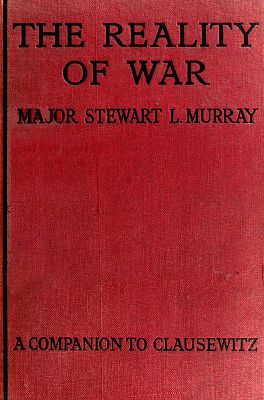
THE REALITY OF WAR
THE
REALITY OF WAR
A COMPANION
TO CLAUSEWITZ
BY
MAJOR STEWART L. MURRAY
LATE GORDON HIGHLANDERS
POPULAR EDITION EDITED BY
A. HILLIARD ATTERIDGE
LONDON
HODDER AND STOUGHTON
WARWICK SQUARE, E.C.
HUGH REES, LTD.
5 REGENT STREET, S.W.
Reprinted in 1914
EDITOR'S PREFACE
Great books, the masterpieces of thespecial branch of knowledge with whichthey deal, are often very big books;and busy men, who have not unlimitedtime for reading, find it helpful to havesome one who will give them a generalsummary of a famous writer's teaching,and point out the most important passagesin which the author himself embodiesthe very essence of his argument.
This is what Major Murray has donefor the most important work on warthat was ever written. He does not givea mere dry summary of its contents.He sets forth, in language so plain thateven the civilian reader or the youngestvisoldier can read it with interest, theessence of the teaching of Clausewitz,and he embodies in his book the moststriking passages of the original work.He adds to each section of his subjectsome useful criticisms, and at the end ofthe book he sums up the effect of recentchanges on the practice of war.
The book is a popular manual of therealities of war, which should be read notonly by soldiers, but by every one whotakes an intelligent interest in the greatevents of our time.
As to the practical value of the writingsof Clausewitz, it may be well to quotehere the words of Mr. Spenser Wilkinson,the Professor of Military History atOxford, from his introduction to theoriginal edition of Major Murray'swork:
"Clausewitz was a Prussian officerwho first saw fighting as a boy in 1793,viiand whose experience of war lasted until1815, when the great war ended. Hewas then thirty-five and spent the nextfifteen years in trying to clear his mindon the subject of war, which he did bywriting a number of military historiesand a systematic treatise 'On War.'At the age of fifty he tied his manuscriptsinto a parcel, hoping to work at themagain on the conclusion of the dutiesfor which he was ordered from home. Alittle more than a year later he died atBreslau of cholera, and the papers, towhich he had never put the finishingtouch, were afterwards published by hiswidow.
"Part of the value of his work is dueto the exceptional opportunities which heenjoyed. When the war of 1806 beganhe had long been the personal adjutantof one of the Prussian princes, and anintimate friend of Scharnhorst, who wasviiiprobably the greatest of Napoleon's contemporaries.In the period of reorganizationwhich followed the Peace of Tilsit hemade the acquaintance of Gneisenau,and of almost all the officers who madetheir mark in the subsequent wars ofliberation. During the years of preparationhe was Scharnhorst's assistant,